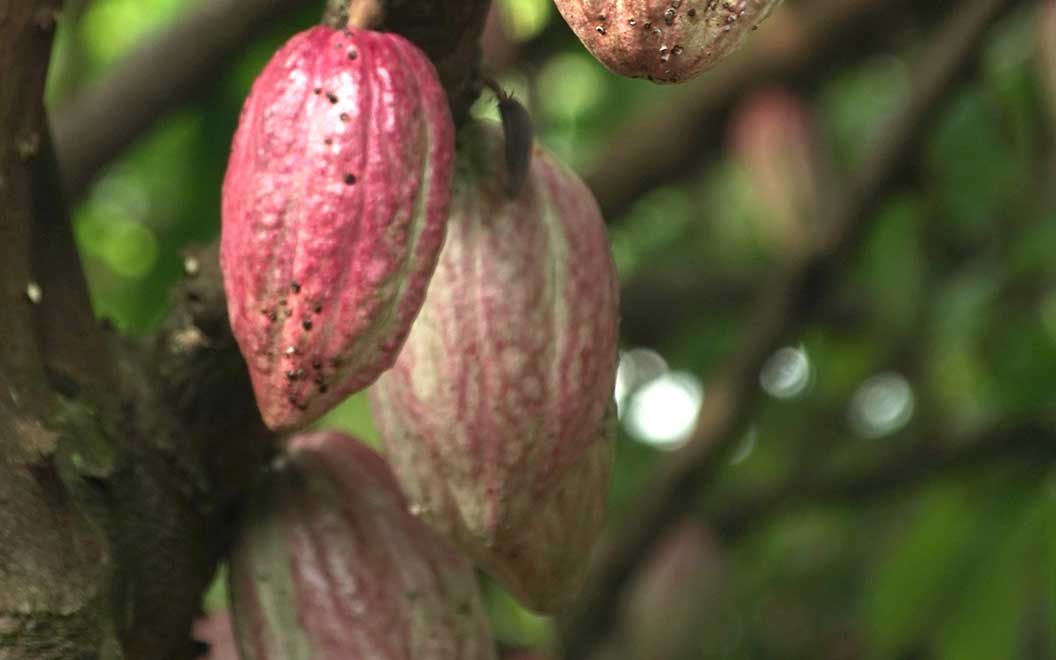NATURE
Nurturing crops is important just as natural as well. Cocoas are planted and raised in rich soils and grow amongst the protective branches of banana trees and mahogany.
A cocoa pod (fruit) is about 17 to 20 cm (6.7 to 7.9 in) long and has a rough, leathery rind about 2 to 3 cm (0.79 to 1.18 in) thick filled with sweet, mucilaginous pulp (called baba de cacao in South America) with a lemonade-like taste enclosing 30 to 50 large seeds that are fairly soft and pale lavender to dark brownish-purple color.
FACTS & STATS
- Soil, climate, origin, tree variety and fermentation all contribute to a cocoa bean’s flavor.
- During fermentation, beans change color and develop their aroma.
- Harvesting is determined by the color and sound of the cocoa pods.
- While on the tree, a ripe pod has a hollow sound if carefully shaken.
VARIETIES
The three main varieties of cocoa plants are Forastero, Criollo, and Trinitario. Forastera is the most widely used, comprising 80–90% of the world production of cocoa. Cocoa beans of the Criollo variety are rarer and considered a delicacy. Criollo also tend to be less resistant to several diseases that attack the cocoa plant. However, this plant is produced in very few countries. One of the largest producers of Criollo beans is Venezuela (Chuao and Porcelana). Trinitario (Trinidad) is a hybrid between Criollo and Forastero varieties. It is considered to be of much higher quality than Forastero. It has higher yields and is more resistant to disease than Criollo.
HEALTH BENEFITS
- Cocoa is rich in polyphenols that help reduce inflammation, improve blood flow, and improve cholesterol and blood sugar levels.
- It also lowers blood pressure by improving nitric oxide.
- Flavanol in cocoa helps lower the risk of heart attack and stroke.
- It aids in weight loss.
HISTORY
Cocoa cultivation began in Ghana and the introduction of this crop to Ghana is attributed to the legend fostered by a blacksmith called Tetteh Quarshie who in 1895, returned to his farm in the Eastern Region of Ghana with cocoa beans “in his pocket” from the island of Fernando Po (now Bioko) in Equatorial Guinea where there was an already intensive plantation production of cocoa.
Cocoa was first exported at the end of the 19th century, and from 1911 to 1976, Ghana was the world’s leading producer, contributing between 30-40% of the world’s total output.
Due to the importance of cocoa in Ghana, both in terms of its effect on the lives of these cocoa farmers and on the Ghanaian economy, the government of the 1930s took over control of the industry. They set up a buying monopoly for all the cocoa produced in Ghana. This body, first under colonial control, and then the independent Ghanaian government, was intended to protect the farmers from price fluctuations. Whilst it failed to ensure a better price to the farmers, they did receive additional help from the other bodies set up by the government body (now known as COCOBOD) such as a Research Institute, subsidized inputs such as fertilisers and a Quality Control Division. It is these services that in part, have preserved Ghana’s reputation for high-quality cocoa.


Comments are closed.